How to start a social media marketing agency in 2025
In this article, I'll show you how to start a social media marketing agency in 2025. You'll learn everything from finding clients to getting paid.

Two years ago I quit my tech job in San Francisco, CA to start my own marketing agency. I made a ton of mistakes my first year, so my agency didn’t really become successful until year two.
But, I learned what I did wrong in the first year.
And in this article, I’ll go over everything you need to know on how to start a social media marketing agency in 2025 so you don’t have to go through the same year-long mistakes I made.
This article took me a while to write so grab a cup of your favorite drink and let’s get into it.
Is it worth starting a social media marketing agency?
Should you start a social media marketing agency? With the right plan, I'd say absolutely! Social media marketing agencies have become super profitable as many businesses realize that creating content on these platforms is the modern-day marketing strategy.
I won't lie — it's challenging at first without an existing track record. You have to conquer hurdles like attracting those early clients, managing time wisely, and building a social media presence. But overcoming these obstacles is completely doable (which I’ll show how in this article).
Successful agencies adapt quickly and adopt new trends. Crafting a compelling value proposition captures attention. Showcasing winning campaigns on your own social accounts builds credibility.
The benefits for clients are major — brand exposure, community engagement, potential SEO boosts, and a reliable traffic pipeline. Social media posts are essential for future-proof marketing.
If you've got a solid business plan and are willing to hustle to land early clients, a social media agency can totally pay off. I'd say the opportunity is better than ever in 2025 if you approach it strategically.
Yes, it takes time, effort, and patience at first. But with the demand out there, a great value proposition, and determination, you can build an agency poised for growth.
But, I will preface this — if you have no experience with social media marketing you should not start an agency. The degree to which your agency will be successful, and you’ll feel fulfilled in your work, will depend on how well you can provide results. I’ll get more into this in step one later in this article.
How much does it cost to start a social media agency?
Starting a social media agency, like any new business, involves initial costs that can vary based on the scale and scope of services you plan to offer.
As an aspiring agency owner, it's crucial to consider various expenses associated with digital marketing, social media management, and content creation. Here's a breakdown of potential costs:
- Setup and operational costs: Includes legal registration, website building, and office supplies. Can range from a few hundred to a few thousand dollars depending on website complexity and legal fees.
- Social media management tools: Essential for efficiently handling multiple client accounts. Tools like Hootsuite, Buffer, or Sprout Social run $15 to $100+ monthly based on needed features.
- Content creation software: Quality content is critical for digital marketing success. Investing in graphic design, video, and content planning tools like Adobe Creative Suite or Canva Pro usually costs between $10 and $50 monthly.
- Email marketing tools: For lead generation and client communication, email platforms like MailChimp or ConvertKit are vital. Basic plans start around $10 to $30 monthly.
- Advertising costs: To promote your agency on social platforms like Facebook, Instagram, or LinkedIn, paid advertising is key. Budgets vary widely from $5 daily up to hundreds of dollars.
- Training and development: Staying on top of the latest social media and digital marketing trends requires ongoing education. Options range from free online resources to paid courses or workshops.
- Testimonials and case studies: Offering discounted services initially can be worthwhile for securing client testimonials and case studies. More of an opportunity cost.
- Insurance and miscellaneous: Don't forget one-off expenses like business insurance or other surprise costs.
7 steps to starting a social media marketing agency
Here are the exact steps I would follow to start a social media marketing agency in 2025:
- Decide what services to provide
- Find a niche that resonates with you
- Set up your website and business
- Find and sign your first client
- Billing and onboarding your first client
- Delivering your services
- Marketing your agency to get more clients
Okay, let’s go through each step in detail.
1. Decide what services to provide
When I started my marketing agency, I zeroed in on the skills I knew inside out thanks to years of hands-on experience. In my book, you shouldn't launch an agency unless you're a bonafide expert in something specific that companies value. You should be in the top 1% in your craft before advising others.
For example, say you worked at a startup and ran their LinkedIn account. Over the year, you grew their following like crazy, boosted engagement, and turned LinkedIn into a prime lead magnet for the business. This experience shows you how to take something from 0 to 100. It also acts as social proof — not just for other potential clients to see your previous work, but also for you to gain the confidence to know you can grow a LinkedIn account.
So when you go solo, offering LinkedIn growth services will feel like a no-brainer. This isn’t about what you’re good at in theory. It’s based on what you had tangible successes in already. Starting with a specialty you have receipts in gives you a major edge in a crowded market.
The lesson? Double down on your proven superpowers. If you've got a track record of real, measurable wins on a certain platform or channel, that's your ticket to compelling consulting offerings. This approach gives you confidence while also reassuring clients you walk the talk. In marketing,, past performance says so much about how you'll do. When experience shows you genuinely have that LinkedIn or Instagram or email magic, lean into it hard.
And once you know what that service looks like, it’s time to package it so it’s easy for potential clients to understand. Which brings me to my next point…
Productize your services
Productizing your services can be a game changer for your agency — I know it was for me. This strategy packages up offerings into clear, concrete things clients can easily grasp. It's been great for managing expectations, attracting clients, and scaling smoothly.
Before, scope creep used to be a huge headache. Projects would slowly balloon beyond the original plan through a million small changes and tweaks. Now each product has firm boundaries on what's covered, so clients and I stay aligned.
For potential customers, laying out services as products simplifies decision-making big time. Here's the scope, timeline, deliverables, and cost. No mystery about what they'll get. This transparency helps close deals faster. People feel more confident signing on when everything's concrete versus abstract.
Productizing also lets you standardize processes and delegate better as you grow. With each product having set steps and outcomes, it's easier to train staff and get consistent quality.
Here’s a great example of a productized service done by ViralCuts:
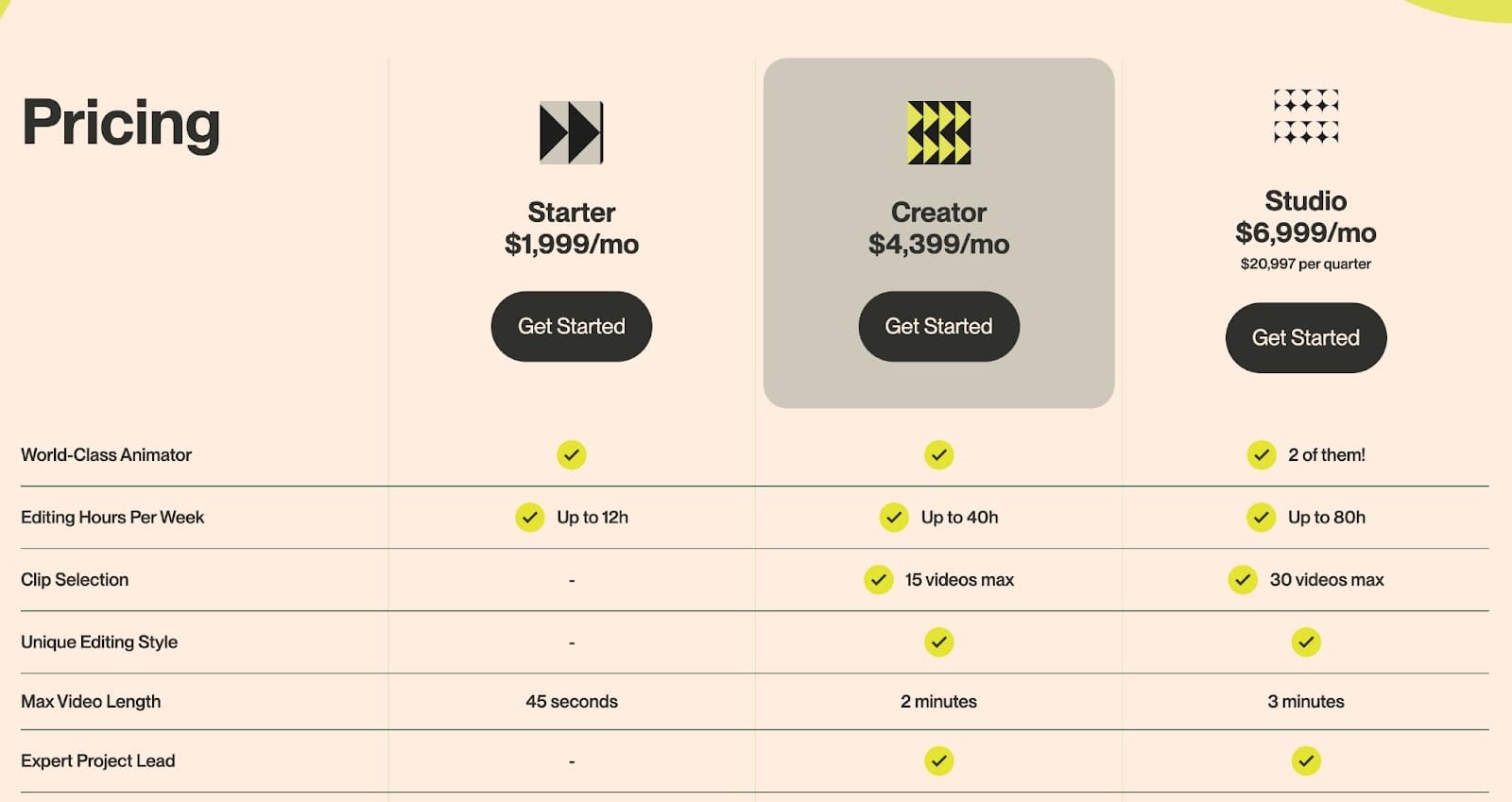
They’re a short-form video agency that helps startups create videos for their social media accounts. From the screenshot above, you can see how they package their services — making their agency feel more like a SaaS (software as a service) company.
2. Find a niche that resonates with you
Finding the right niche for your social media agency is crucial — it needs to fully resonate with you while also filling a market need. Personally, I focused on areas I was naturally passionate about and curious to learn more about.
When you genuinely love what you do, it shows in the quality of your work and how well you serve clients. It will also help you push forward and have discipline when you don’t feel like working.
But passion alone isn't enough. Your niche should also be one where startups and businesses actively spend on social media services. No sense in entering a ghost town with no demand. I did tons of market research to spot sectors investing heavily in social media for outreach and engagement. And one easy way I knew companies would want my services was because I hired an agency at my previous job. Again, this is why real “9-5” experience is so important when starting an agency.
For example, you could notice a surge of fitness startups leveraging social media to build their brands and communities. You could also be passionate about fitness and wellness yourself. This serves as a great niche you could geek out on while serving many potential clients.
The takeaway? Find where your passion intersects with real business needs out there. Let interest and curiosity drive you while pursuing opportunities. This leads to rewarding, engaging work while also setting up your agency for profit. A niche that energizes you but also fills a void is marketing gold.
3. Set up your website and business
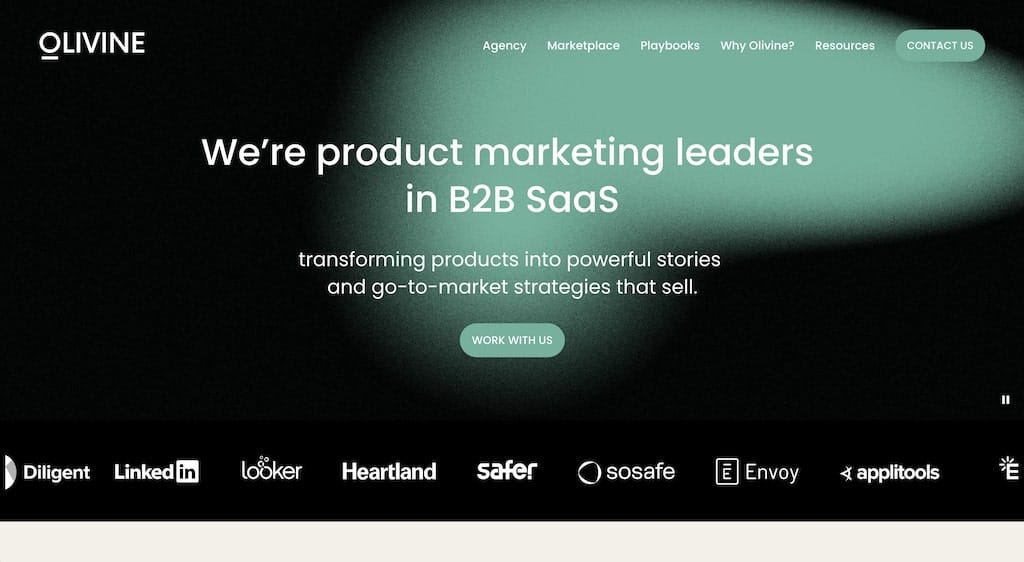
A polished website is hugely important for any social media agency — it's your digital storefront and first impression. When starting out, I used Webflow for the flexibility and design control. But platforms like Squarespace, Wix, or WordPress work too depending on your needs.
Equally key was integrating a client portal for streamlined communication, billing, and management. I used Assembly's white-labeled portal which connects seamlessly to my site. This lets clients log in directly and access their dedicated backend space on my marketing agency’s website.
The client portal is a game-changer. Clients can track projects, communicate, and access documents all in one place. It makes the experience personalized and simple.

If you want to connect Assembly's portal to your website, I wrote a few guides for different platforms:
- Webflow: Integrating a client portal with Webflow
- Squarespace: Setting up a client portal in Squarespace
- Wix: Creating a client portal on Wix
- WordPress: How to create a client portal in WordPress
Each guide walks through the process from start to finish.
Remember, your website and portal represent your brand and expertise. Investing time to set them up correctly is crucial for success and growth. First impressions matter big time — don't leave it to chance.
4. Find and sign your first client
Once you know what service(s) you want to offer, who you want to offer them to, and have a home on the internet were people can learn more about you, it’s time to get your first client.
There’s no right or wrong way to find your first client. But, here are a few ways you can go about it:
- Reach out to your existing network: One of the first steps you can take is to tap into your existing network. This includes friends, family, former colleagues, or anyone who might benefit from your social media services. While this approach may not always yield the best results, especially if you have a specific niche in mind, it's a good starting point to get the word out and possibly gather some referrals.
- Direct outreach on LinkedIn (my favorite method): This method has proven to be the most effective for me. Start by identifying a list of companies you’d love to work with on LinkedIn. Then, research to find out who the CEOs or decision-makers are within these companies. Then, use a tool like Hunter.io to find their email addresses. Send them an email offering something of value upfront, like a free social media strategy session, to pique their interest. You can end your email with an offer to hop on a call and at the meeting you can pitch your services. This direct and personalized approach is how I landed my first client, and it has led to some of my highest-paying clients as well.
- Leverage online marketplaces: Platforms like Upwork, Growth Collective, or MarketerHire can be great resources. These marketplaces connect freelancers and agencies with companies in need of specific services. While there's higher competition on these platforms, they offer the opportunity to access a wide range of potential clients actively seeking social media marketing services.
Remember, landing your first client is often the hardest part, but it's also the most rewarding. I can’t explain how ecstatic I felt when that first check came in. It's about persistence, personalization, and leveraging the right channels. Once you secure that first client, not only does it validate your business idea, but it also sets the foundation for future growth and success.
5. Billing and onboarding your client
Landing that first client is a huge win, but the real work starts with billing and onboarding them smoothly. These early touches make a big impact on the relationship.
Billing your client
Billing for the first time can feel awkward, but it's all about being clear, concise, and professional. I wrote an article on exactly how to do this but I’ll give a quick rundown here. Here are the steps you want to follow when billing a client:
- Send a proposal: Here you want to clearly outline the scope of work, timeline, and price. If you have a productized service with packages on your website, you can sort of bypass this step. However, some companies are still getting used to this new wave of productized agencies and may ask for a more traditional proposal approach.
- Get the contract signed: Depending on the size of the company you are working with, you’ll either have to send a contract, sign a contract the company sends you (like an NDA), or have a verbal agreement (ideally written down somewhere like in an email). If you have a productized service, you can have a policy page on your website that goes over this.
- Figure out payment terms: Here you want to discuss the frequency of payments. With Assembly, you can send individual invoices or you can create recurring subscriptions.
- Send your invoice via Assembly: Assembly has a built-in invoice template generator, making it easy to add deliverables, payment methods, attachments, and your client's name to each invoice.
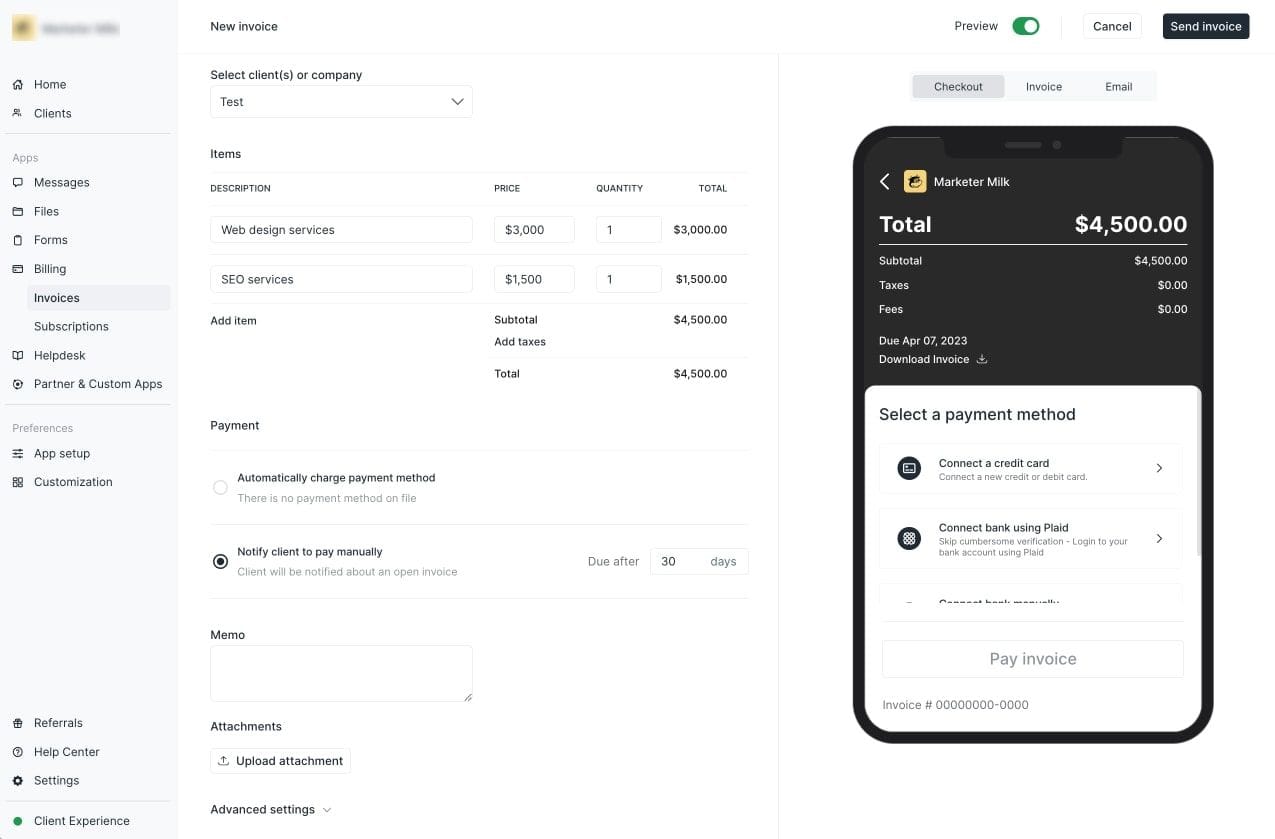
Tools like Assembly make creating polished invoices a breeze. And don't hesitate to clarify any payment questions — transparency builds trust.
Next, you want to onboard your client.
Onboarding your client
Solid onboarding is also key to start things off right. Automating repetitive tasks is a huge help here. With Assembly, you can automate sending welcome emails, gathering client info, setting up accounts, and sharing questionnaires. This saves tons of time while making sure each client gets a consistent, personalized experience.
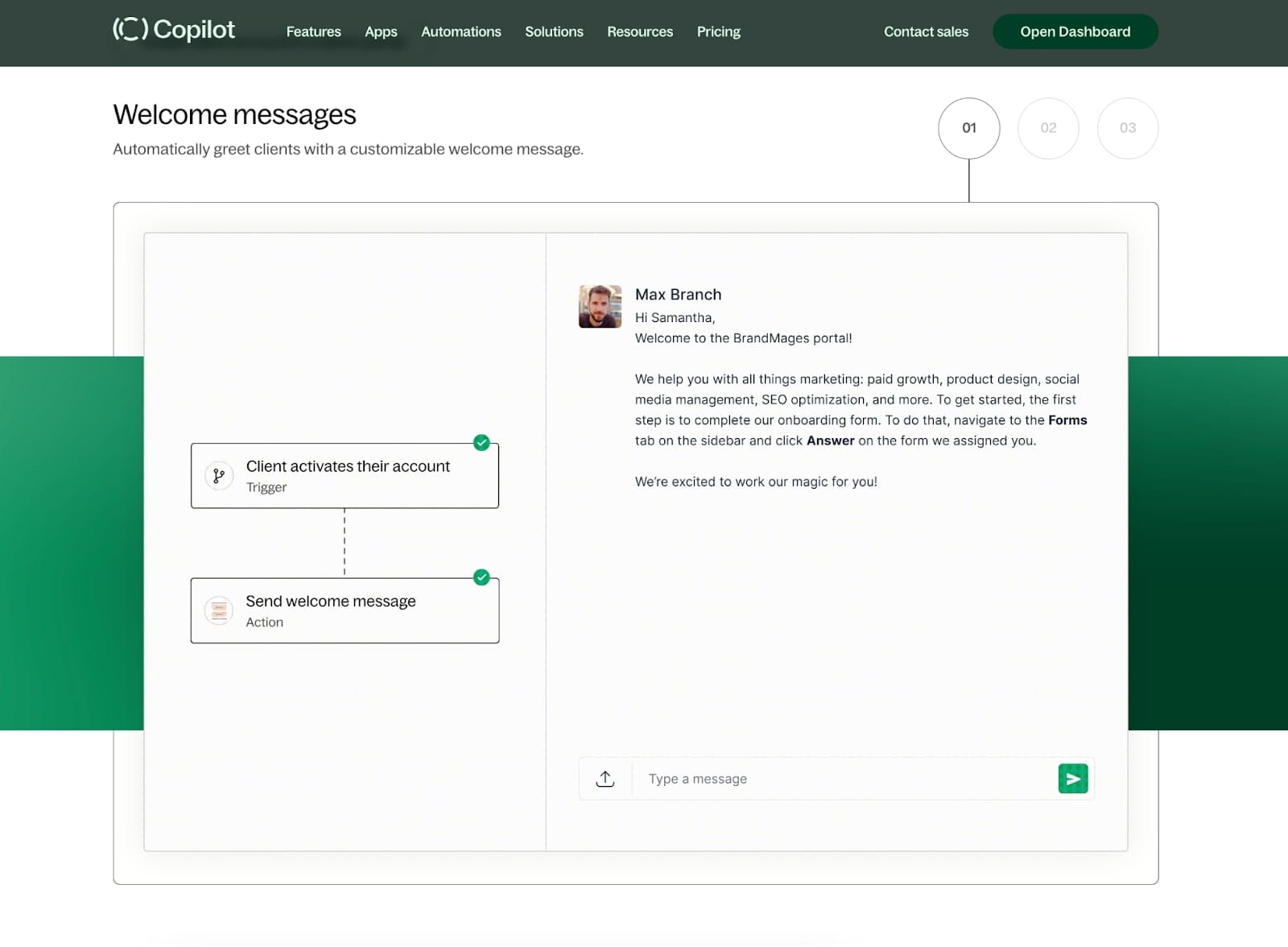
Onboarding automation not only boosts efficiency, but it lets you focus on more strategic aspects of your services. A structured onboarding process gives clients confidence in your partnership from day one.
In summary, dialed-in billing and onboarding demonstrate your professionalism while paving the way for smooth collaboration ahead. Leverage tools and best practices to make these processes efficient yet personal. The early wins get clients excited for the journey with you.
Related Reads: 6-step client onboarding checklist for agencies
6. Delivering your services
Delivering services smoothly is make or break for client satisfaction. The most common concern I hear from companies that have worked with agencies in the past is that “they weren’t that good.” And to be honest, being on the side where I’m working in-house and outsourcing to an agency, I can say that a good agency is extremely rare to come by.
This is why I mentioned early in our steps that you should only really start an agency when you’re in the top 1% of your craft. Some of the best consultants and agency founders I know either worked in-house at a company or an agency for at least 3-5 years before they ventured out on their own.
And, another personal thing, many people will tell you that project management is key to having a successful agency. And while that can hold true, I’ve found that being able to deliver amazing results, consistently, beats any system or project management framework you can come up with.
But once you deliver great results, being organized and having a system for project management and client reporting is the icing on the cake. With so many marketing agency tools out there, this part can become easy. This is where Assembly shines for me.
It seamlessly integrates with other platforms I use daily — Notion, Asana, Airtable, Google Analytics, ClickUp, etc. Being able to embed these into each client's portal is a game-changer. Clients can log in anytime to view real-time progress and milestones. It's incredibly transparent — they see how projects evolve step-by-step and clients love this visibility.
Assembly also makes sharing files and deliverables a breeze. I can easily upload documents, reports, videos, and more to the portal. Clients access and download files right from their dashboard — no more emailing attachments back and forth!
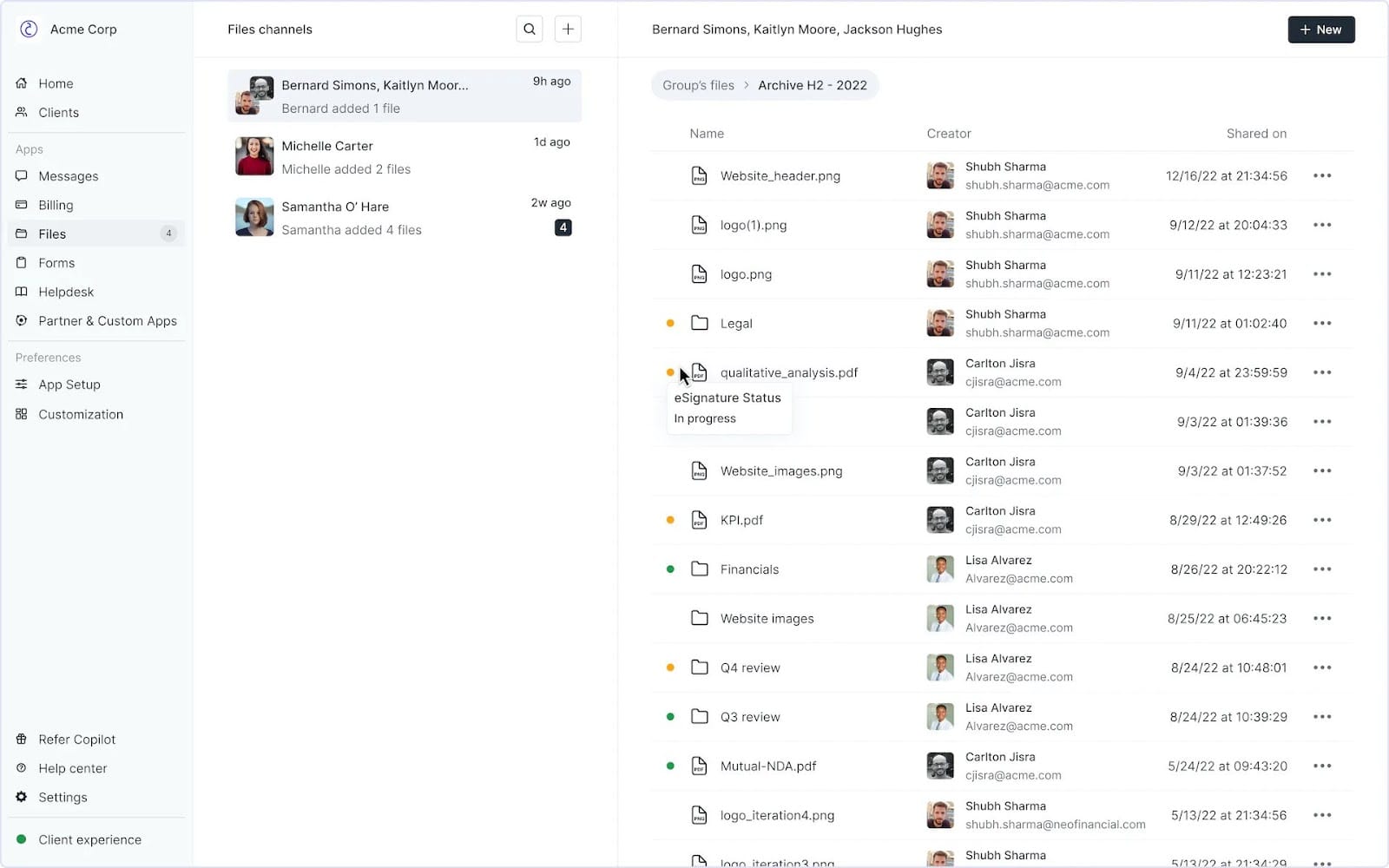
Having this centralized hub keeps everything organized in one spot. It streamlines communication and simplifies project management big time. This level of organization and accessibility goes so far in maintaining professional, efficient relationships. It takes the hassle out of service delivery, letting you focus on quality work. And it keeps clients in the loop, contributing to their satisfaction.
The degree to which you deliver quality work, and keep your clients happy, determines how long you will be able to retain them. And the longer you retain your clients, the more likely they are to recommend you to other companies that could use your services. This is how most agencies and freelancer marketers eventually get a consistent stream of clients.
7. Marketing your agency to get more clients
To effectively market your social media marketing agency and attract more clients, it’s crucial to practice what you preach — a concept known as "dogfooding" your own services.
This means if you’re offering LinkedIn growth services, your agency should have a thriving and engaging LinkedIn presence. This not only serves as proof of your expertise but also helps in attracting inbound leads. Similarly, if TikTok growth is your forte, having a thriving TikTok account demonstrates your capability and knowledge in this space.
Here are some other strategies you can leverage to market your agency effectively:
- LinkedIn content: Regularly post insightful articles, updates, and engage with your network on LinkedIn to maintain a strong professional presence.
- Short-form videos: Utilize social media platforms like TikTok and Instagram Reels to create engaging, informative short videos that highlight your skill sets and services.
- YouTube channel: Start a channel to share longer-form content, such as tutorials, case studies, or industry insights.
- Start a newsletter: Keep your audience informed and engaged with regular updates, tips, and insights through a newsletter.
- SEO and blogging: Create a blog on your website with SEO-optimized content to attract organic traffic and establish your agency as a knowledge leader (this is what I do).
- Google PPC ads: Invest in pay-per-click advertising on Google to target potential clients actively searching for social media marketing services.
- Cold email outreach: Craft hyper-personalized cold emails to reach out to potential clients who might benefit from your services (my favorite).
- Case studies: Develop detailed case studies showcasing your successes with past clients to provide tangible proof of your expertise.
- Sponsor industry newsletters: Gain visibility by sponsoring newsletters that are popular in your industry niche.
- Influencer partnerships: Collaborating with influencers can help expand reach. Costs vary greatly depending on audience size and campaign type.
- Ask for referrals: Encourage satisfied clients to refer others to your agency. Sometimes a word-of-mouth recommendation can be the most powerful marketing tool.
If you want to go into more detail on any of these, I wrote a full guide on how to grow your clientele for your digital marketing agency you should check out. The main takeaway is to find 1-2 channels that work the best for you and to just focus on those. If you have success with signing high-quality clients through email, no need to go spend money on ads.
Hopefully, by now, you know what it takes to start a social media marketing agency!
Assembly: The modern client portal for marketing agencies
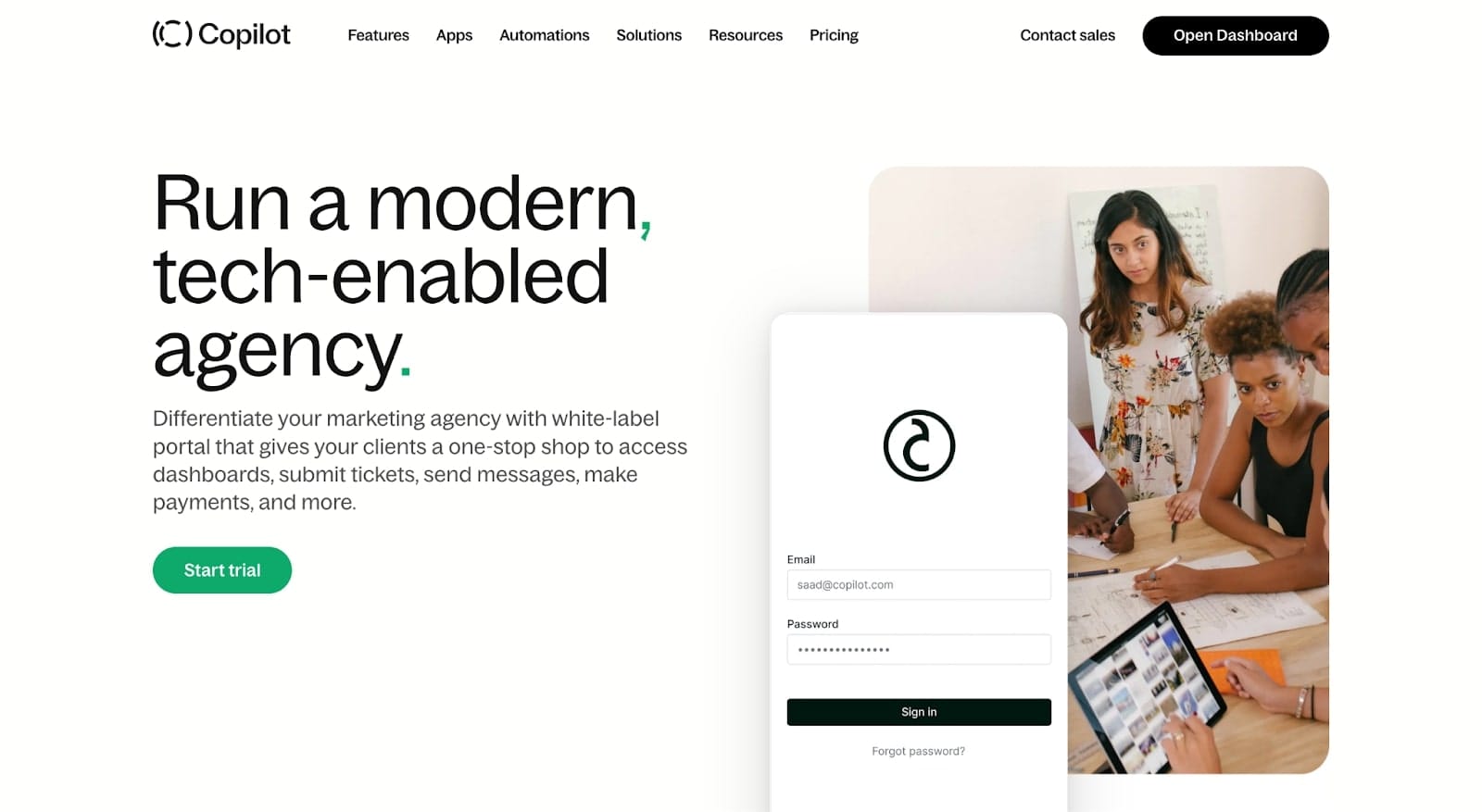
Starting your own social media marketing agency is an exciting journey. And to do it right, you need both a combination of the right skills and the right tools that simplify operations and wow clients. This is where Assembly delivers for modern marketing agencies.
For entrepreneurs juggling multiple social media channels and strategies across client accounts, Assembly brings order to the chaos. It centralizes everything into one slick client portal — project timelines, communications, documents, and reports all in one place. This transparency builds client trust and loyalty over the long haul.
Assembly also automates routine tasks so agencies can focus on creative strategy versus admin stuff. Whether it's scheduling content, tracking analytics, or managing feedback, Assembly smooths these operations.
For agencies targeting new clients, Assembly also demonstrates cutting-edge service commitment from the start. And for small business owners wearing many hats, having this simplified social media command center removes hassles so they can execute more effectively.
If you’re ready to take your social media marketing agency to the next level, be sure to play around with Assembly’s demo portal!

